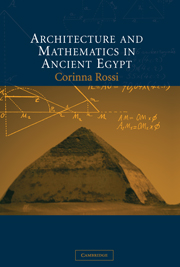Book contents
- Frontmatter
- Contents
- List of illustrations
- List of tables
- Preface
- Acknowledgments
- List of abbreviations
- Part I Proportions in ancient Egyptian architecture
- Introduction to Part I: Harmony and proportions in architecture
- 1 In search of ‘the rule’ for ancient Egyptian architecture
- 2 Mathematics and architecture in ancient Egypt
- Conclusion to Part I: Ancient mathematics and practical operations
- Part I Ancient Egyptian sources: construction and representation of space
- Part III The geometry of pyramids
- Conclusion to Part III: Interpreting the slope of pyramids
- An overview
- Appendix: List of Old and Middle Kingdom true pyramids
- Bibliography
- Index
1 - In search of ‘the rule’ for ancient Egyptian architecture
Published online by Cambridge University Press: 27 February 2010
- Frontmatter
- Contents
- List of illustrations
- List of tables
- Preface
- Acknowledgments
- List of abbreviations
- Part I Proportions in ancient Egyptian architecture
- Introduction to Part I: Harmony and proportions in architecture
- 1 In search of ‘the rule’ for ancient Egyptian architecture
- 2 Mathematics and architecture in ancient Egypt
- Conclusion to Part I: Ancient mathematics and practical operations
- Part I Ancient Egyptian sources: construction and representation of space
- Part III The geometry of pyramids
- Conclusion to Part III: Interpreting the slope of pyramids
- An overview
- Appendix: List of Old and Middle Kingdom true pyramids
- Bibliography
- Index
Summary
Triangles and other figures
Three triangles for ancient Egypt
Before the diffusion of the Napoleonic Description de l'Egypte, the available information on Egyptian architecture was fragmentary and imprecise, and did not necessarily create a good impression on architectural historians, especially those accustomed to the reproductions of Greek art and architecture. The French architectural historian Quatremère de Quincy, for instance, was not exactly a supporter of ancient Egypt. He believed that ancient Egyptian architecture lacked ‘order’, meaning a ‘system of proportions of forms and ornaments’, and that beauty and taste were foreign to it. In his Dictionnaire Historique d'Architecture, he wrote that in Egyptian architecture the large size of the construction, the vastness of the composition and the profuseness of signs and objects were due to a lack of science, a lack of creativity, and a lack of taste, respectively. He concluded that the best way to mould someone's taste, to develop a feeling for truth and beauty, was to familiarise them with Greek statuary. But if one wished to prevent this feeling from developing, it would be enough to condemn the person to looking at Egyptian statues. If one looks at the appalling reproductions of Egyptian monuments that accompanied his texts (for example fig. 1), the temptation to agree with him is very strong.
Ancient Egyptian architecture began to be included in the studies on architectural proportions when more reliable reproductions of the monuments became available.
- Type
- Chapter
- Information
- Architecture and Mathematics in Ancient Egypt , pp. 7 - 56Publisher: Cambridge University PressPrint publication year: 2004



